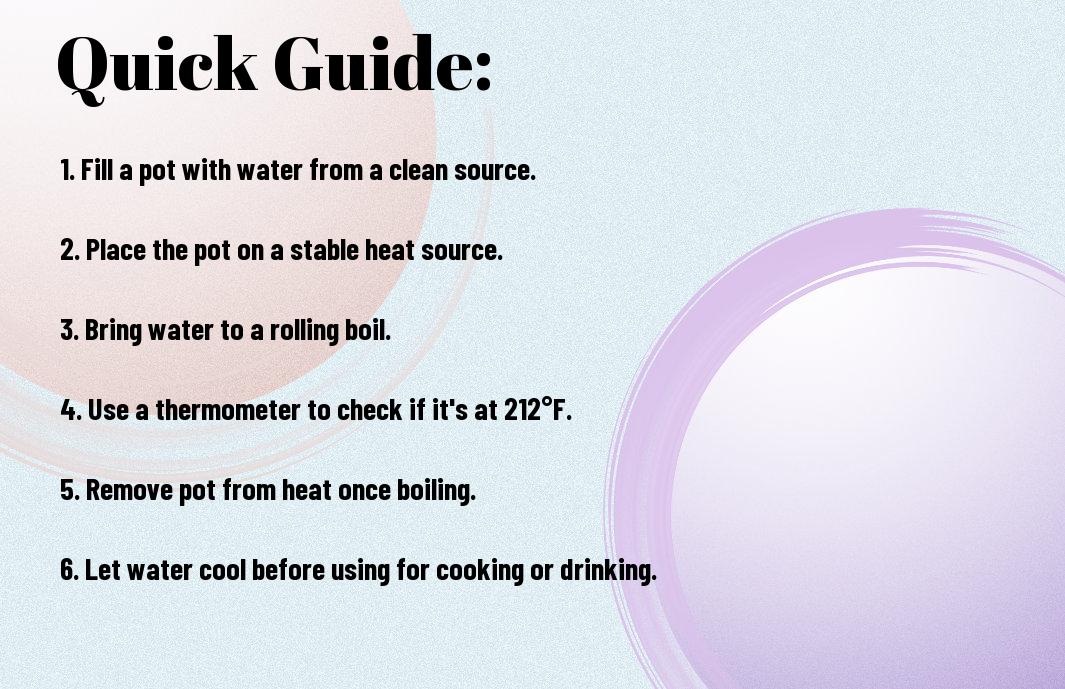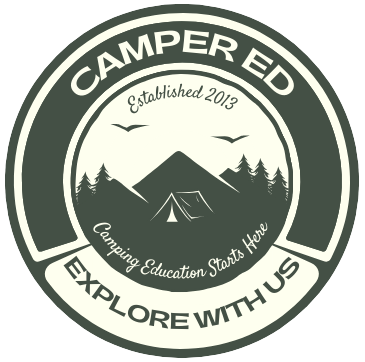You love the great outdoors, but cooking a meal while camping can sometimes be a challenge. One important skill that every camper should master is knowing how to boil water efficiently. Whether you need hot water for a warm drink, instant meal, or to purify it for drinking, this step-by-step guide will ensure you can do so safely and easily during your outdoor adventures.

Understanding the Importance of Boiling Water
Why Boiling Water is Crucial for Camping
A key aspect of camping is ensuring that you have access to safe drinking water. Boiling water is a fundamental step in water purification that effectively kills harmful bacteria, parasites, and viruses that may be present in natural water sources. By heating water to a rolling boil for at least one minute (or longer at higher altitudes), you can significantly reduce the risk of waterborne illnesses during your outdoor adventures.
Risks of Not Boiling Water
With contaminated water sources being common in the wilderness, not boiling water before consumption can lead to severe consequences. Drinking untreated water can expose you to a range of waterborne diseases such as Giardia, E. coli, or Cryptosporidium, causing symptoms like diarrhea, vomiting, and dehydration. These illnesses can quickly ruin your camping trip and even pose serious health risks, especially when medical help is not readily available.
Understanding the risks of consuming untreated water underscores the importance of boiling water as a straightforward and effective method for safeguarding your health during camping trips. Prioritizing water safety through boiling ensures that you can fully enjoy outdoor activities without the worry of falling ill due to contaminated water sources.
Types of Water Sources for Camping
While camping, it’s crucial to find a reliable water source to ensure you stay hydrated and can cook your meals properly. Different types of water sources are available for campers to use during their outdoor adventures. Perceiving the differences between these sources can help you make the best choice for your camping trip.
Sources: Natural Sources (Rivers, Lakes, Streams)
Sources of water in nature such as rivers, lakes, and streams can be refreshing and easily accessible during your camping trip. However, it’s important to purify this water before consuming it to remove any harmful bacteria or contaminants. Boiling the water is a reliable method to make it safe for drinking. Additionally, you can use water filters or water purification tablets to ensure the water is clean and safe for consumption.
Sources: Stored Water (Bottled, Tankered)
When camping in areas where natural water sources are not available or reliable, you can opt for stored water such as bottled water or water that you bring in a tanker. This water is already treated and safe for drinking, making it a convenient option for your camping trip. Make sure you have an adequate supply of stored water to last throughout your stay in the campground.
Types of water sources for camping can vary depending on your location and the facilities available in the area. When choosing your water source, consider factors such as convenience, availability, and safety to ensure you have a pleasant camping experience.
Now: Recycled Water (Rainwater, Greywater)
Now, let’s talk about recycled water sources like rainwater and greywater. Collecting rainwater can be a sustainable way to access water during your camping trip, especially in areas where natural sources are scarce. Greywater, which is water from activities like washing dishes or showering, can also be treated and reused for non-potable purposes, such as cleaning or watering plants.
Streams and other sources of recycled water can provide additional options for campers looking to minimize their environmental impact while enjoying the great outdoors. Be sure to properly treat and filter recycled water before use to avoid any potential health risks.
Factors to Consider Before Boiling Water
Now, before you begin the process of boiling water while camping, there are several important factors to consider to ensure the safety and efficiency of your water purification.
Water Quality and Contamination
If you are unsure about the quality of water at your campsite, it is crucial to purify it before consumption. Filtering the water through a portable water filter or using water purification tablets can help eliminate harmful bacteria and parasites that may be present. Additionally, be mindful of any sources of contamination such as animal waste, chemicals, or debris that could affect the water quality.
Altitude and Atmospheric Pressure
For optimal boiling water at higher altitudes, you need to consider the impact of reduced atmospheric pressure. At higher elevations, water boils at a lower temperature, which means you will need to boil it for a longer period to ensure it is safe for drinking.
To prevent potential health risks due to incomplete sterilization, it is recommended to bring the water to a rolling boil for at least one minute at altitudes above 6,500 feet. Perceiving the altitude of your camping location will help you adjust your boiling time accordingly.
Equipment and Fuel Availability
While preparing for boiling water at your campsite, consider the availability of equipment and fuel. Make sure you have a reliable camping stove, matches, or a lighter to start your fire. Additionally, carrying extra fuel can save you from running out of resources when you need them the most.
Contamination from improperly sanitized equipment or lack of fuel to boil water can lead to potential health hazards. Always ensure your equipment is clean and in good condition before use.
Step-by-Step Guide to Boiling Water
Not only is boiling water a fundamental skill for camping, but it’s also imperative for your health and safety. Follow this step-by-step guide to ensure you have safe drinking water during your outdoor adventures.
| Choosing the Right Equipment (Stoves, Pots, Fuel) | |
| Right | Before you head out on your camping trip, make sure you have the right equipment for boiling water. You will need a camping stove, a pot or kettle for heating the water, and fuel such as propane or butane. |
Measuring and Treating the Water
Now, when it comes to measuring the water you need to boil, use a water bottle or other container to measure the amount you require. Additionally, consider treating the water with purification tablets or a portable water filter to ensure it is safe to drink.
| Fuel | |
| Boiling | For efficient boiling, make sure you have enough fuel for your camping stove. It’s a good idea to bring extra fuel in case you need to boil water multiple times during your trip. |
Heating and Boiling the Water
Boiling water while camping is a simple process. Place your pot or kettle on the stove, ignite the flame, and heat the water until it reaches a rolling boil. This bubbling action indicates that the water is safe to drink and free from harmful bacteria and microorganisms.
Cooling and Storing the Boiled Water
Heating the water is just the first step. Once the water has boiled, remember to let it cool down before transferring it to a clean water bottle or container for storage. This will prevent any burns and ensure you have a refreshing drink of water whenever you need it.
The safety of your drinking water while camping should be a top priority. By following these simple steps, you can ensure that you have access to clean and safe drinking water no matter where your outdoor adventures take you.
Tips for Boiling Water While Camping
After mastering the art of boiling water outdoors, there are a few tips you should keep in mind to make the process more efficient and safe.
Energy Efficiency and Fuel Conservation
Little adjustments in your boiling technique can go a long way in conserving fuel and making your camping experience more eco-friendly. Opt for a lid on your pot to retain heat and boil water faster. Also, try to use a windscreen to shield the flame from breezes and prevent heat loss. These small changes can make a big difference in the amount of fuel you use during your trip.
Assume that you can conserve fuel by only boiling the amount of water you need. There’s no need to fill your pot to the brim if you only require a cup or two for your meal or hot beverage.
Water Conservation Techniques
Any camper worth their salt knows the importance of conserving water, especially in outdoor environments where resources are limited. When boiling water, make sure to reuse any excess water for tasks like cleaning dishes or even dousing the campfire at the end of the night. Every drop counts in the wilderness!
The key to successful water conservation techniques is to be mindful of your usage and always look for ways to repurpose water that you’ve already heated up. By incorporating these habits into your camping routine, you’ll not only save water but also reduce your impact on the environment.
Safety Precautions and Emergency Procedures
Precautions should always be taken when dealing with boiling water in a campsite. Be sure to keep a safe distance from the flames to avoid accidental burns, and use sturdy pot holders or gloves when handling hot cookware. Additionally, make sure your cooking area is stable and level to prevent spills and potential injuries.
Safety is paramount when it comes to outdoor cooking, so always have a plan in place for emergencies. In case of accidental burns, immediately cool the affected area with cold water and seek medical help if necessary.
Pros and Cons of Boiling Water Methods
Your decision to purify water by boiling comes with its own set of advantages and disadvantages. Let’s break them down in the table below:
| Advantages | Disadvantages |
| Kills harmful bacteria, viruses, and parasites | Time-consuming process |
| Accessible and cost-effective method | Requires a heat source |
| Can be done with basic camping equipment | Uses fuel or energy |
Advantages of Boiling Water (Kills Bacteria, Viruses, etc.)
There’s nothing quite as reassuring as knowing that by simply boiling water, you can eliminate harmful bacteria, viruses, and parasites that can otherwise cause illness. This method is effective in killing most microorganisms that may be present in natural water sources, making it a reliable way to ensure the water you consume is safe for drinking.
Disadvantages of Boiling Water (Time-Consuming, Energy-Intensive)
Water boiling does have its drawbacks. The process can be time-consuming, especially if you need to boil a large quantity of water or if you are using a low-powered heat source. Additionally, it requires a significant amount of energy, whether that be in the form of fuel for a camp stove or firewood for a campfire.
Bacteria, viruses, and other pathogens are effectively neutralized when water reaches a rolling boil, but this doesn’t happen instantaneously. It can take several minutes of sustained boiling for water to become safe for consumption, which may not always be convenient, especially in urgent situations.
Conclusion
So, now you have all the knowledge and skills you need to boil water while camping like a pro. By following the step-by-step guide provided in this article, you can ensure that you always have safe and clean water to drink, cook, and clean with during your outdoor adventures. Remember to pack a portable stove or a camping pot on your next trip, and you’ll be all set to boil water wherever you go.
Just be sure to follow the safety precautions, use the right equipment, and enjoy the simplicity and satisfaction of mastering this crucial camping skill. Boiling water is a fundamental survival technique that every camper should know, so keep practicing and perfecting your technique for the next time you head out into the great outdoors!
